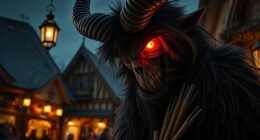The historical evidence around the Beast of Gévaudan combines eyewitness sightings, local records, and legends, creating a mysterious story of a creature blamed for many attacks in 18th-century France. Descriptions point to a large, fierce animal that defies natural explanation, with some suggesting it was a wolf or hybrid. Despite efforts to hunt it down, no definitive proof has emerged. If you keep exploring, you’ll uncover the enduring debate and what makes this legend so enthralling.
Key Takeaways
- Historical records document numerous attacks attributed to a large, ferocious creature in 18th-century Gévaudan.
- Sightings describe a wolf-like or hybrid animal with exceptional size and strength, fueling theories of a unique or mythical beast.
- Authorities conducted multiple hunts with inconsistent results, but no conclusive evidence identified the creature.
- Legends and local stories have preserved the mystery, influencing cultural perceptions and ongoing debates.
- Modern analysis suggests the creature was likely a large wolf, wolf-dog hybrid, or rabid animal, though definitive proof remains elusive.

The legend of the Beast of Gévaudan continues to captivate and intrigue, even centuries after its reign of terror. You’re probably familiar with the tales passed down through local legends, stories that have persisted in the region for generations. These legends paint a picture of a mysterious, monstrous creature responsible for the deaths of dozens of villagers, mostly women and children, during the 18th century. Over the years, many have wondered whether these stories are purely myth or if there’s some kernel of truth behind them. One of the reasons this mystery endures is due to cryptid sightings, reports of strange beasts that seem to defy explanation. Such sightings fuel speculation that the beast might have been a unique creature, perhaps a wolf hybrid, or something even more fantastical. Despite the passage of time, some witnesses claim to have seen large, wolf-like animals or strange figures lurking in the woods of Gévaudan, adding layers to the legend. These cryptid sightings have kept the story alive, encouraging both locals and historians to revisit the accounts and evidence surrounding the beast.
Historical evidence, however, paints a more complex picture. Many reports from the time describe a creature larger than a wolf, with unusual strength and ferocity. But historians have debated whether the attacks were caused by a single beast or a pack. Some suggest that the creature was a wolf or a wolf-dog hybrid, possibly rabid, which could explain the unusually aggressive behavior. Others argue that the attacks were exaggerated or even orchestrated to cover up human conflicts or fear. Records from that era indicate that the local authorities tried to hunt down and kill the beast, with varying degrees of success. These efforts, along with accounts from witnesses, form the basis of much of the evidence we examine today. While no definitive proof has ever emerged to identify the creature conclusively, the pattern of attacks, the descriptions, and the cryptid sightings continue to fuel debates. The truth remains elusive, but what’s clear is that the legend has become woven into the fabric of local culture, with stories that have persisted for centuries. Whether you see the Beast of Gévaudan as a real creature, a mythic symbol, or something in between, its story continues to challenge what we believe about the natural world and the power of local legends.
Frequently Asked Questions
Were There Any Modern Sightings of the Beast After the 18TH Century?
Yes, there have been modern cryptid sightings of the Beast of Gévaudan after the 18th century. You might find reports influenced by folklore, fueling tales of a mysterious creature lurking in the region. These sightings often blend local legends with cryptid folklore, keeping the legend alive. While no solid evidence exists, the stories persist, inspiring curiosity and speculation about whether a creature still roams in the shadows today.
You witness how the beast’s terror left lasting scars on Gévaudan communities, with over 100 victims fueling community trauma and societal paranoia. Fear permeated daily life, leading to increased distrust and vigilantism. Local populations became isolated, and fear of another attack heightened, deeply affecting social cohesion. The terror’s aftermath reshaped community interactions, fostering suspicion and anxiety that persisted long after the attacks stopped.
Could the Beast Have Been a European Wolf or Wolf-Dog Hybrid?
You might think the beast was a European wolf or a wolf hybrid, and it’s a plausible idea. A wolf hybrid, blending wolf and dog traits, could explain its unusual behavior and strength. Some experts suggest the creature could have been a large, aggressive European wolf, possibly driven to unusual acts by environmental factors or scarcity. While not definitive, this theory aligns with the beast’s characteristics and the region’s wildlife.
How Did Local Folklore Influence Reports and Interpretations of the Beast?
Folklore influence greatly shaped how you perceived eyewitness accounts of the beast. Local stories about monsters and supernatural creatures heightened fears, leading you to interpret ambiguous sightings as evidence of a monstrous beast. These tales influenced your perceptions, causing you to see more sinister features or behaviors than there might have been. As a result, folklore created a feedback loop, reinforcing fears and shaping reports into more dramatic and terrifying accounts.
Are There Any Recent Scientific Theories Explaining the Beast’s Origins?
Scientists now explore the Beast’s origins through genetic analysis, revealing intriguing clues about its prehistoric roots. You might be surprised to learn that recent theories suggest it could be linked to ancient predators long thought extinct. This discovery sparks a sense of mystery and wonder, making you question whether the beast was a unique creature or a surviving remnant from a distant past, lurking silently in history’s shadows.
Conclusion
As you step back from the shadows of the Gévaudan legend, you realize it’s a tapestry woven with mystery and truth. The beast, like a ghost in the fog, whispers secrets of a turbulent past. Though time has muted its roar, the echoes remind you that history’s monsters often lurk where stories blur reality and myth. Maybe, in unraveling this tale, you’ve uncovered more than just a beast—you’ve glimpsed the wild heart of human fear.









